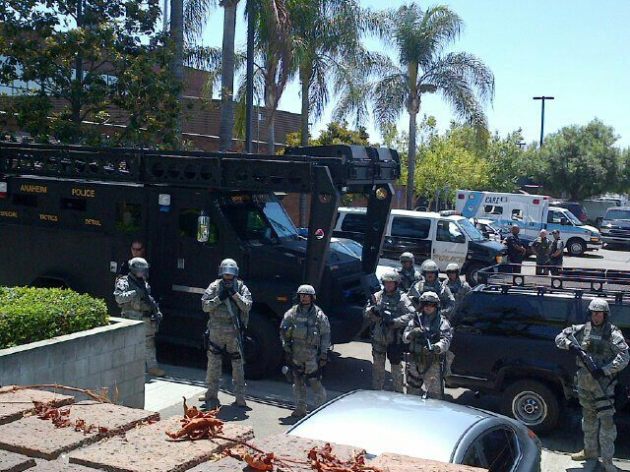We have seen the photographs and videos from the OWS protests across the nation. Police armed with assault rifles and grenade launchers. Police outfitted with military uniforms and body armor. Police using this equipment against the (typically unarmed) protesters.
Most people don’t even ask the simple, but glaring question: Where do the police get this equipment? Who is funding it?
The answer to that question lies in the National Defense Appropriations Act for Fiscal Year 1997, as well as 10 USC 2576(a). Under color of law, the Department of Defense now has a Law Enforcement Support Office (LESO), which, in its mission statement provides ‘excess Department of Defense (DOD) personal property to federal, state, and local law enforcement agencies (LEAs).’
This program allows the LEAs to purchase, for a cost of pennies on the dollar, ‘surplus’ military equipment. Further, the DoD is authorized to donate such equipment to LEAs for free. Since 1997 the DoD has transferred $2.6BN of equipment and hardware to LEAs. The equipment consists of armored vehicles, weapons, aircraft, watercraft, body armor, and other types of gear and hardware. In 2011 alone, the amount of equipment was valued at almost half a billion dollars. The number of requests and transfers has increased exponentially over the last few years.
https://www.dispositionservices.dla.mil/rtd03/leso/Program%20Statistics.ppt
Think about that. $2,600,000,000.00 of your Federal tax dollars are being spent to equip police with military hardware. Congress’ intent was that such equipment should primarily be used in counter-terrorism and drug operations, when they could reasonably expect considerable armed resistance, but also allowed for ‘suitable use by the agencies in law enforcement activities.’ Thus, the police are allowed to use this equipment in other situations, such as when facing off against unarmed protesters.
Thus you end up with a quasi-military force that is entirely exempted from the Posse Comitatus Act of 1878. Of course, it is noteworthy that since 1878 the powers that be in DC have found ways to whittle away at the Act and its limitations against the use of federal military personnel in domestic policing actions. These limitations were further eroded by the formal establishment of the National Guard, which, unless federalized by the President, are solely under the command of the governors of the various States in which the Guard units are located.
The militarization of law enforcement provides a heavily armed, heavily armored police force that avoids the uncomfortable scrutiny that would accompany utilization of the National Guard or active duty military forces. The local municipalities can simply say, ‘We merely responded with a strong police presence.’ To the uninitiated, and even to some of us who are far more experienced, the difference seems to be merely academic. When police arrive on scene in military uniforms, carrying military weapons, and backed up by armored vehicles then we must ask ourselves whether or not any sort of distinction is left to be made. Of course, the police, in such situations, have far greater power than the National Guardsmen would. They have powers of arrest and detention, powers to deprive someone of their essential liberties and Constitutionally-guaranteed rights. Even more troublesome is that they, unlike the military, exercise those powers on a daily basis, and are far more desensitized to the Constitutional implications of their actions.
It should be a simple thing to make a request of your local police force, to ascertain what equipment they have received, what funds have been expended in acquiring such equipment. It is our duty, as citizens, to question the actions of our government and its agencies. Let them know we are watching. Let them know that we are paying attention.
In the face of such firepower it is vital that we do what we can to check the continued militarization of the police forces, as it represents a paradigm shift in the nature of what the police are intended to do. They are to ‘protect and to serve,’ not ‘subjugate and intimidate.’

That’s not even quasi military. They’re in uniform, wearing military rank, doing military jobs and doing them against our citizens. That’s exactly what they wanted to prevent when they started off that old forgotten “we the people” document.
http://www.saveamericafoundation.com/2012/07/31/the-militarization-of-domestic-law-enforcement-agencies-by-shawn-c-bugbee-foreword-by-fred-brownbill/